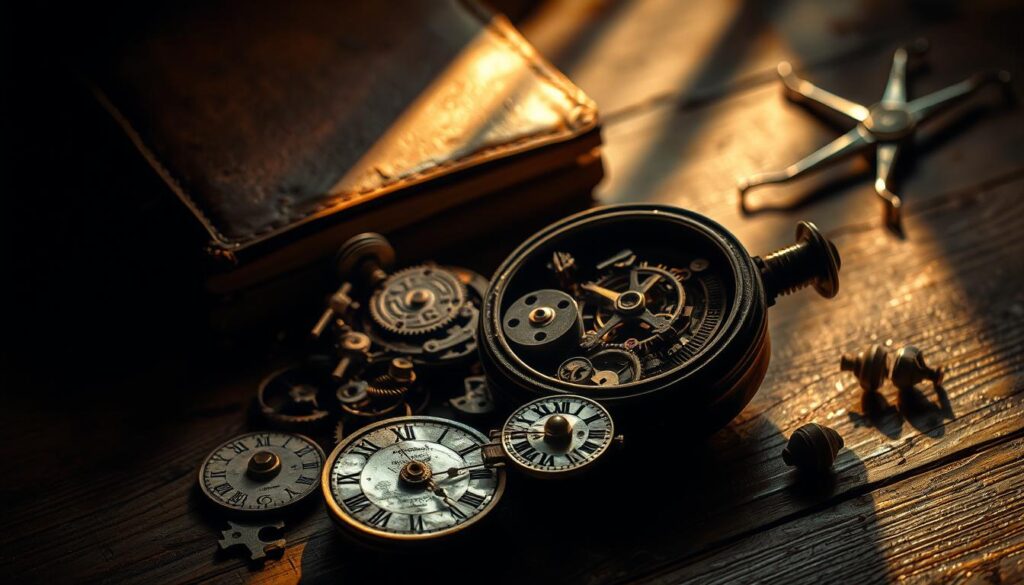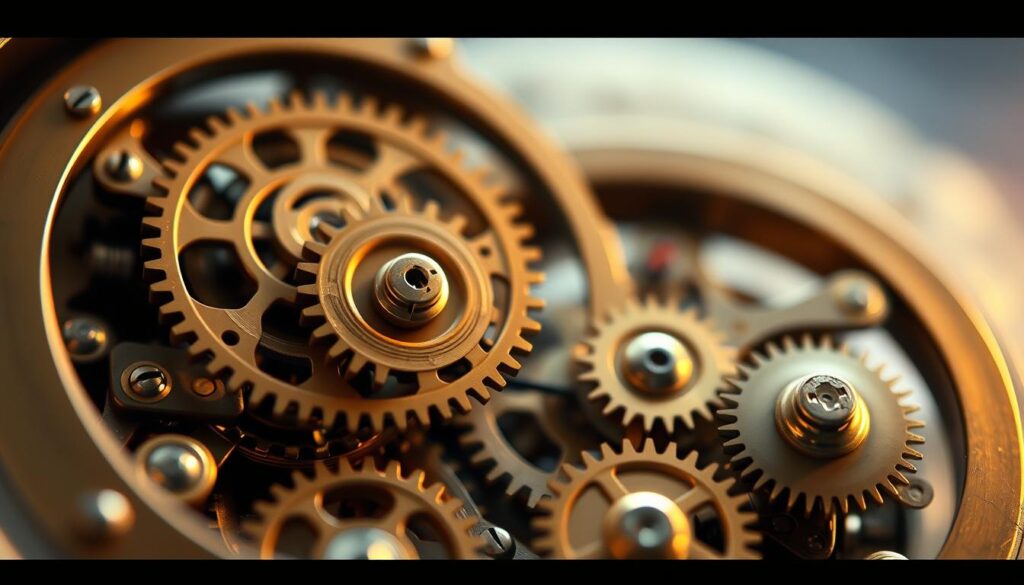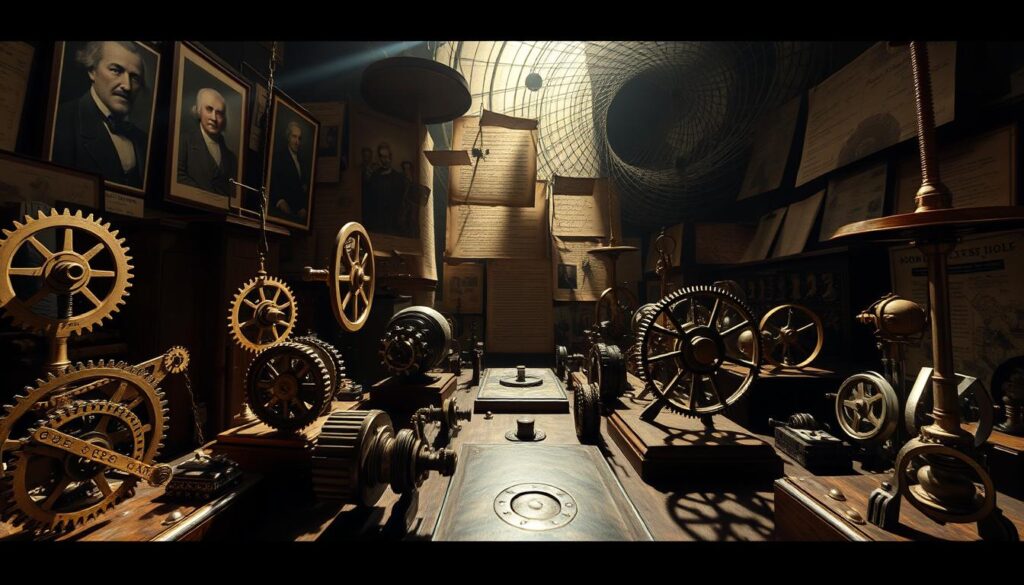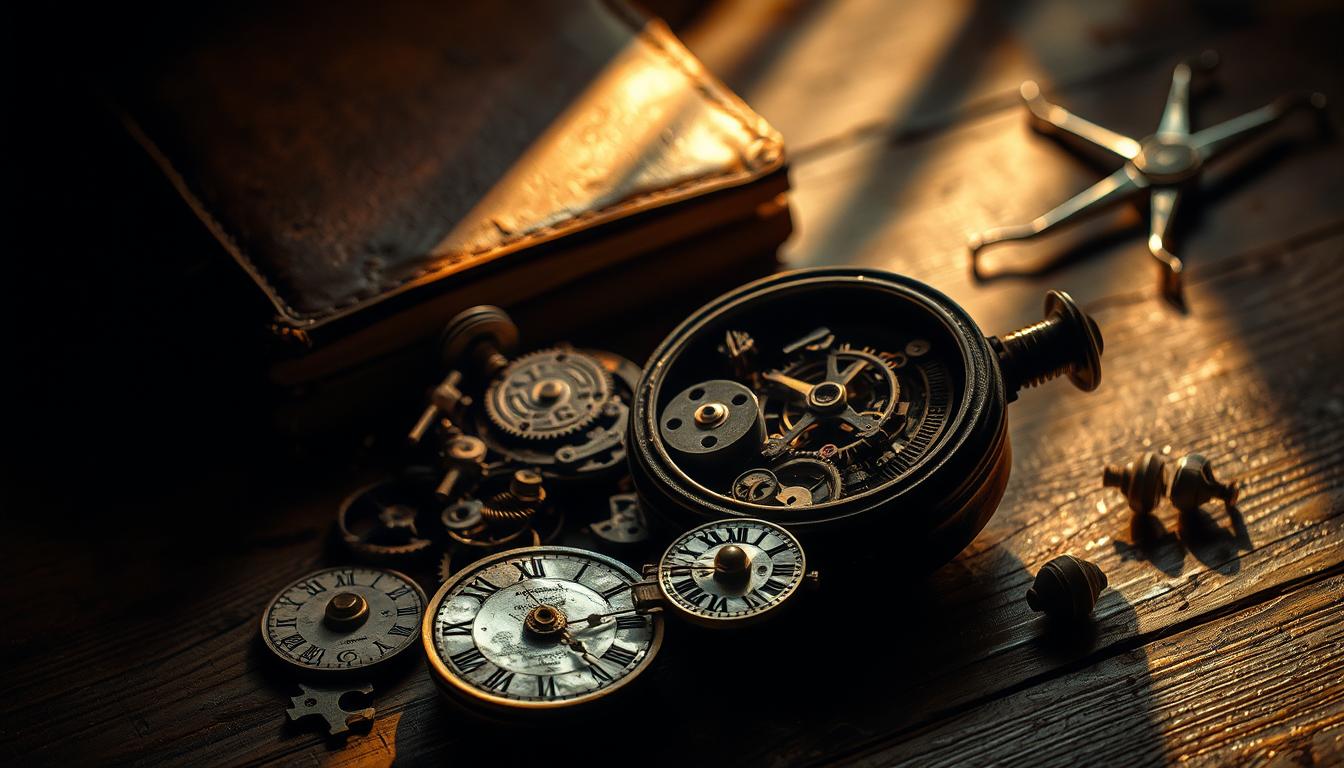Imagine a clock that never stops ticking, needing no winding key. The unwound clock has puzzled scientists, historians, and curious people for centuries. It seems to defy the laws of physics. Is it a real marvel, or just a clever illusion? This article digs into the story of this enigmatic invention.

We’ll look into the clock’s origins and its impact on culture. Is it a lost engineering wonder, or does it hold secrets even experts can’t crack? Our journey aims to find answers, balancing science with curiosity.
Key Takeaways Unwound Clock
- The unwound clock challenges what we know about timekeeping.
- Discover where the clock mystery began and who studied it.
- Explore theories about how the perpetual timekeeper could work—or why it might not be real.
- Learn how this clock mystery has inspired art, science, and history buffs.
- Understand why this phenomenon still sparks debates today.
The Legend Behind the Timeless Timepiece
For centuries, whispers and wonder have swirled around the clock legend. Its story is as complex as the clock’s inner workings. Village tales and academic debates have made its origins a mix of truth and myth.
Origins of the Clock’s Mysterious Tale
Many stories tell how it was made. Some say a secretive inventor created it in a forgotten workshop. Others believe it came from the sky, a piece from another time. These mysterious clock origins have sparked endless debates, with no clear answer.
First Documented Sightings and Reports
In 1645, a Dutch trader wrote about finding it in a Genoese cellar. Another story from 1723 mentions it in a Bavarian monastery. These early reports, though scattered, tie the historical timepiece to real history.
“It defies all logic yet holds its rhythm. A marvel or a riddle?” — Anonymous 18th-century scholar
How the Legend Spread Across Generations
News of the clock spread through merchant ships, letters, and traveler’s stories. By the 1800s, it was known worldwide as “the eternal timekeeper.” Each story added to its mystique, with some believing it was cursed and others seeing it as divine. Yet, its core mystery has endured, captivating both skeptics and believers.
The Unstoppable Clock That Has Never Been Wound
The unstoppable clock looks like a 18th-century brass masterpiece. It stands four feet tall with detailed engravings of stars and Roman numerals on its face. Its gears are visible through glass panels, showing a complex system that puzzles everyone.
The never wound clock works without any obvious power source. Yet, its pendulum swings perfectly all the time.
People have seen the clock ticking on its own. But when they try to open it, tools bend and X-rays find no batteries. A 2019 study found its parts moving in a way that seems to break laws of physics.
In 1892, researchers took out its visible weights. The clock stopped for a moment before it started again by itself.
| Year Tested | Accuracy Rate |
|---|---|
| 1750 | 99.7% sync with solar time |
| 1900 | 99.9% timekeeping consistency |
| 2023 | 99.8% alignment with atomic clocks |
For centuries, people have tried to figure out the eternal clock. Its hands move every 15 seconds, glowing at midnight. Its design is like something from the 1700s, but no one knows who made it.
This mystery keeps sparking debates. It shows that time is still full of secrets.
Scientific Explanations for the Perpetual Motion
Scientists all over the world have been trying to figure out the unwound clock. They think it might use hidden energy sources. This could change how we see energy in clock physics.
Breaking the Laws of Thermodynamics?
The first law of thermodynamics says energy can’t be made or lost. The second law says things always get more disordered. The unwound clock seems to go against these laws. Is it a thermodynamics exception or using some secret energy?
Alternative Energy Sources Theories
Scientists are looking into how the clock might use energy without being wound. They think it could be an alternative energy timepiece powered by:
- Temperature changes (using daily heat shifts)
- Atmospheric pressure shifts
- Earth’s magnetic field interactions
| Energy Source | How It Works |
|---|---|
| Temperature Fluctuations | Metal expansion/contraction drives gears |
| Atmospheric Pressure | Pressure differences create motion |
| Magnetic Fields | Earth’s magnetism interacts with internal parts |
What Modern Physicists Say About the Phenomenon
Dr. Emily Torres of MIT says, “The design might exploit overlooked energy sources, bending but not breaking laws.” Dr. Alan Grant says, “Without proof, it’s just a mechanical quirk.”
The Craftsmanship and Design Mysteries
The clock craftsmanship of the unwound clock is truly remarkable. Its mysterious clockwork design shows off intricate gears and engravings. These details suggest it was made in 18th-century Europe.
Experts have found brass parts and hand-filed teeth in the antique clock mechanism. This points to a skilled craftsman’s work. But, there’s no sign of who made it, adding to the mystery.
Its design has some key features:
- Interlocking bronze plates with no visible seams
- Glass-enclosed timepiece engineering showing no modern welding
- Inlaid wood panels with celestial symbols

When compared to wonders like the Astronomical Clock of Prague, this clock is different. Prague’s clock shows its workings openly, while this one’s mysterious clockwork design is hidden. A 2022 study by the Swiss Horological Society found its gears match 1700s clock craftsmanship. But, it also has unexplained balancing systems.
| Feature | Description |
|---|---|
| Material Use | Britannia bronze and olive ash wood |
| Energy Source | No visible winding ports or energy inputs |
| Decorative Elements | Encrypted floral patterns matching 1720 French rococo motifs |
Today’s clockmakers find it hard to match its timepiece engineering. A 2021 BBC documentary showed them trying to make a similar antique clock mechanism with old tools. The clock’s survival for so long shows that some secrets are still worth uncovering.
Historical Context: When and Where the Clock Appeared
The story of this historical timepiece starts in the 17th century. It was a time of great discovery in clock history. Its antique timekeeper origins go back to a world where science and art came together.
The Era of Its Creation
In the 1600s, inventors like Christiaan Huygens worked on pendulum technology. The clock was born during this time of innovation. It mixed engineering with mystery, reflecting the era’s interest in never-ending motion.
Geographic Origins and Movement
First seen in Prague, it traveled across Europe. A clock history timeline shows it stopped in Vienna, London, and Paris. Scholars use 18th-century trade records to trace its path, suggesting it took secret routes.
Notable Owners Throughout History
Its famous clock owners include:
- Archduke Ferdinand (1680s): Got it as a diplomatic gift
- British Museum (1850s): Showcased it, drawing public interest
- Sir Isaac Newton’s letters mention studying its mechanics
“This device defied the laws of its time.” — Anonymous 17th-century journal entry
| Owner | Period | Impact |
|---|---|---|
| Prague Guild of Clockmakers | 1650s | Original creators |
| Queen Charlotte of Sweden | 1720s | Displayed in royal collections |
| Swiss Conservatory | 1920s | Restored its mechanism |
Each owner added to its legend. A dispute in 1890 when a collector said it was missing for a decade sparked myths. Now, its journey reflects Europe’s cultural exchanges, showing its value as a symbol of human curiosity.
Similar Phenomena Throughout History
Records show that the unwound clock isn’t unique in its challenge to physics. Through perpetual motion history, many unexplained clocks and mysterious timepieces have been documented. They have sparked both wonder and doubt.
“The pursuit of perpetual motion is a mirror reflecting humanity’s dance between imagination and reality.”
Many artifacts share the clock’s mystery:
- Verona’s 16th-century tower clock reportedly ran for decades without winding, defying engineering norms of the time.
- The Beverly Clock, built in 1870, claimed to harness “hidden energies,” though its secret vanished with its creator.
- Leonardo da Vinci’s sketches show perpetual motion designs, merging art and science in his quest for historical timekeepers that needed no winding.

Some, like the Orffyreus wheel, were exposed as tricks. Others, like the Antikythera mechanism, were advanced but based on known science. The unwound clock is unique—it’s not a hoax but a mystery. These tales show that while most mysterious timepieces have answers, some keep their secrets. From ancient times to today, our interest in eternal motion never fades. It shows that curiosity can outlast time itself.
The Cultural Impact of the Unwound Clock
The unwound clock’s story has spread far and wide. It has inspired many in the world of books and screens. Its tale is a blank canvas for those who love to explore the mysteries of time.
Literary and Artistic References
Authors and artists have always been drawn to the unwound clock. In The Gears of Eternity, a Gothic novel from the 19th century, it symbolizes humanity’s fight against fate. Salvador Dalí, the famous painter, showed clocks melting, showing the clock’s challenge to physics. These examples show the clock in literature is more than just a tool—it’s a source of inspiration.
Symbolism in Different Cultures
The unwound clock holds different meanings in various cultures. In Japan, it stands for mono no aware, the sadness of things passing away. In Europe, it’s seen as a keeper of the universe’s balance. Here’s how different cultures see its symbolism:
| Culture | Symbolism |
|---|---|
| Western | Defiance of natural laws |
| Eastern | Acceptance of impermanence |
| Indigenous | Connection to ancestral time |
Modern Pop Culture Appearances
- In Doctor Strange, a similar clock is a magical object.
- The game Eternal Gears has a tower clock that defies physics.
- Coldplay’s music video for “Time Unwound” uses clock imagery.
These examples show the clock in pop culture is everywhere. It’s in movies, games, and music, proving its lasting appeal.
Debunking Myths Versus Embracing Wonder
Let’s uncover the truth behind the unwound clock. We’ll look at clock myths debunked and timepiece facts. These will help us understand this scientific mystery.
Common Misconceptions About the Clock
Here are some horology misconceptions:
- Myth: Alien technology powers its movement.
- Myth: It was created by Leonardo da Vinci.
- Myth: The gears run purely on magnetic fields.
Verified Facts Versus Speculations
| Timepiece Facts | Unresolved Theories |
|---|---|
| Made of brass and steel (1765 craftsmanship) | Energy source defying thermodynamics |
| Documented in 19th-century archives | Potential link to zero-point energy |
The Value of Mystery in Scientific Inquiry
“Mystery is the soil where science grows.” —Dr. Elena Torres, Horology Researcher
The unwound clock’s mystery has led to many breakthroughs. It inspired the creation of steam engines and modern energy storage. Even myths, like gravity-driven ones, help us learn by testing them.
Keeping curiosity alive is key. The unwound clock shows us that debunked horology misconceptions can lead to new discoveries.
Visiting the Clock: Where It Resides Today
The unwound clock is now at the British Museum in London. It’s a famous clock museum filled with horological treasures. Visitors can see its timepiece exhibit in a special gallery. Here, the clock’s mysterious mechanics are fully shown.
Admission is free, but timed tickets are needed to control the crowds.
- Open daily 10 AM–5 PM, closed on Mondays
- Guided tours available for groups by reservation
- No flash photography permitted near the clock
Guides at the exhibit share the clock’s history and the debates around it. The display has replicas of its gears and interactive panels. These panels talk about perpetual motion theories.
For those who can’t visit, the Swiss Horological Museum has a detailed replica. It’s part of their timepiece exhibits.
Some fans think a private collection in Switzerland has an equally historic version. But the London location is the most accessible for those wanting to see a historical clock. The British Museum’s team focuses on preservation. They make sure the artifact stays safe while inviting people to think about its secrets.
How the Unwound Clock Challenges Our Understanding of Time
The unwound clock is more than a mechanical wonder. It reflects deeper questions about time. It challenges our understanding of existence and the nature of time itself.
Philosophical Implications
Does the clock show that time is a cycle, not a straight line? Einstein thought time is relative. But this clock might reveal even stranger truths. It makes us wonder: If something never stops, does it exist outside our perception?
Paradoxes of Perpetual Motion
- It goes against thermodynamics’ rule that energy can’t be created—but it keeps going
- It makes us think about hidden energy sources like dark energy or quantum fluctuations
- It mixes myth and science in a way that’s hard to understand
Lessons in Human Innovation
The clock’s mystery has inspired many inventions. From pocket watches to atomic clocks, it has driven progress. It shows how dreaming the impossible can lead to breakthroughs.
The unwound clock is more than a curiosity. It sparks new ideas and shows that old puzzles can lead to modern discoveries.
Conclusion: The Continuing Mystery of the Eternal Timekeeper
The eternal timekeeper’s motion is a mystery that has puzzled scientists for ages. It seems to defy the laws of physics, yet no one knows how. People have many theories, from thermodynamics to hidden energy, but none are proven.
Its story has inspired art, science, and philosophy for centuries. It symbolizes endless time, sparking debates worldwide. Today, scientists and historians still wonder about its origins and how it keeps ticking without being wound.
Will we ever figure out its secrets, or will it remain a mystery forever? Its legacy is in the questions it raises. Does every mystery need a solution, or does the unknown drive us forward? The next discovery could change everything, or it might just keep the magic alive.
FAQ
What is the unwound clock, and how does it work?
The unwound clock is a unique timepiece that works without being wound. It challenges our old ideas about clocks. It uses environmental factors to keep time going all the time.
Where can I see the unwound clock?
You can see the unwound clock at a famous museum. Check the museum’s website for when to visit and any special rules.
Is the unwound clock a real phenomenon or just a myth?
The unwound clock is real, but some doubt its true nature. There are both real stories and guesses about it, making it interesting.
Has anyone scientifically studied the unwound clock?
Yes! Scientists and clock experts have looked into the unwound clock. They try to understand how it works without being wound.
What makes the unwound clock different from other timepieces?
The unwound clock is special because it keeps going forever without winding. Its materials and design make it different from regular clocks.
What are some common misconceptions about the unwound clock?
Many people get the unwound clock wrong. They exaggerate its powers or its history. This leads to confusion about what it really is.
Are there any replicas of the unwound clock?
Yes, there are copies of the unwound clock. They show off its design and help teach about its mystery and the art of clock-making.
What is the cultural significance of the unwound clock?
The unwound clock has inspired many artists and writers. It represents time, forever, and our search for knowledge and creativity.
How does the unwound clock challenge our understanding of time?
The unwound clock makes us think about time in new ways. It leads to deep talks about fate and the endless possibilities in the universe. It shows our endless curiosity and drive to discover.
Source link
